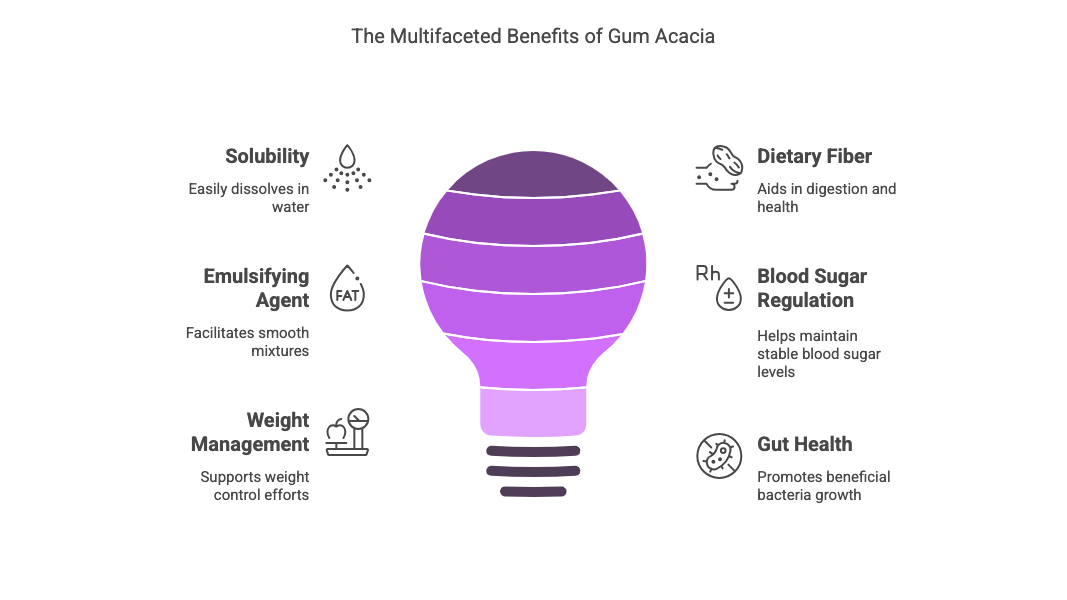Key Highlights
- Gum acacia, also known as gum arabic, is a natural gum derived from the dried exudate of acacia trees such as Acacia senegal and Vachellia seyal.
- It plays a critical role in the food industry as a stabilizer, thickener, and emulsifier, particularly in soft drinks and confectionery.
- This food additive is rich in dietary fiber and offers significant health benefits such as improved metabolism and digestive health.
- Gum acacia has been used for centuries, including in traditional medicine and art forms like watercolor painting.
- It is vital to local communities in African regions like the Sahel, providing economic support through exports worldwide.
- Beyond food, gum acacia has various industrial applications—ranging from pharmaceuticals and cosmetics to ceramics and photography.

Introduction to Gum Acacia
In today’s fast-paced world, maintaining a healthy diet can be a challenge. One simple addition that can transform your nutritional intake is gum acacia, a natural fiber that’s been revered for its health benefits and culinary uses for centuries. Imagine feeling lighter, healthier, and more energized simply by incorporating this unique ingredient into your diet. With 70% of adults not getting enough fiber, leading to discomfort and weakened immunity, gum acacia presents a promising solution.
Gum acacia is produced from the sap of the Acacia tree bark. When the tree is naturally injured or cut, it secretes a sap that, over time, thickens and hardens into small crystals. These crystals are then harvested, purified, and used in various commercial preparations. This fiber is a staple in Asian and African cuisines and is celebrated for its versatility and health benefits.

Health Benefits of Gum Acacia
Gum acacia is more than just a fiber. It makes its way to the colon, nourishing our gut microbiome. These microbiomes love gum acacia, rewarding us by producing short-chain fatty acids that suppress appetite, boost immunity, and maintain the integrity of our gut. Incorporating gum acacia can lead to a longer, healthier life, where you’re more comfortable in your skin and stomach.
Properties and Uses of Gum Acacia
This natural wonder is chemically a glycoprotein, known for being easily soluble in water—hot or cold. It acts as a safe dietary fiber, often used in pharmaceuticals, cookies, candies, and desserts. Gum acacia is a powerful emulsifying agent, allowing for smooth mixtures when combining water and fat, a property utilized in many cuisines and industries. As a fiber, it helps regulate blood sugar, manage weight, and promote the growth of beneficial bacteria, reducing cravings and overeating.

Gum Acacia vs. Xanthum Gum
Often confused with Xanthum gum due to their tree-based origins, gum acacia stands out as a prebiotic. While Xanthum gum is cheaper and a great thickening agent, gum acacia excels as an emulsifier with added health benefits. It’s essential to choose based on your dietary goals—whether as an emulsifying agent or a thickening enhancer.
Gum Acacia in Cuisine and Health
Gum acacia is a cherished element in Middle Eastern and Indian cuisines, used in salad dressings, candies, and for digestive health. Although some studies hint at its potential in reducing prostate hypertrophy and aiding kidney health, more research is needed. Its benefits are enhanced by the method of harvesting and purity, reinforcing its position as a safe, neutral, non-immunogenic prebiotic.

Conclusion and Final Thoughts
Gum acacia is a treasure trove of nutritional benefits that should be incorporated into everyone’s dietary routine. From boosting gut and immune health to acting as a versatile culinary ingredient, its potential is vast. As you consider your fiber intake, remember that gum acacia is not just a dietary fiber—it’s a key to a happier, healthier life.

Frequently Asked Questions
How does Gum Acacia differ from other types of gum?
Gum acacia is different from other plant gums. It comes mainly from Acacia senegal and Vachellia seyal. This gum dissolves smoothly in water and offers benefits as dietary fiber. Compared to other gums, gum arabic plays a big part in food, art, and medicine because of its special qualities.
Can Gum Acacia be used in vegan products?
Yes, gum acacia comes from plants, so it is great for vegan products. It works as a food additive and helps to mix and thicken foods. This fits well with vegan values, making it popular among people who care about nutrition.
Are there any known allergies associated with Gum Acacia?
Gum acacia allergies are uncommon, but they can happen due to sensitivity. This may cause mild side effects, such as stomach issues. Always read food labels carefully. Also, talk to a healthcare provider to stay safe, especially if you are allergic to plant-based additives.


